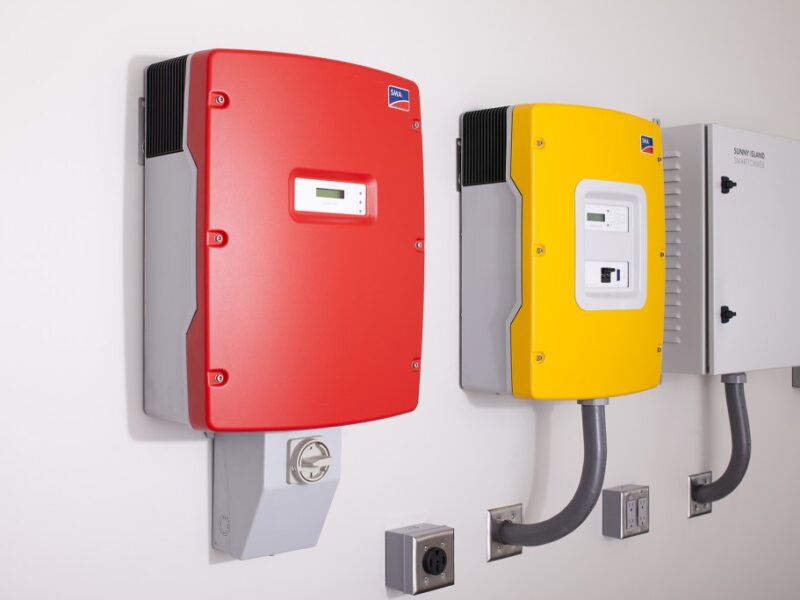Solar Battery Storage
If you are considering a new solar power system, you should weigh up the potential advantages of battery storage for your situation. Battery storage allows you to store the excess solar power you generate from your solar panels. Instead of sending this solar energy back to the grid, and receiving a low feed in tariff, you could choose to store your energy in a battery for later use. Without a battery, the electricity grid acts as your storage mechanism, only you have to pay far more for the electricity!
For off grid systems, batteries are imperative; for grid tied systems, batteries can be financially viable and advantageous.
What are Solar Batteries?
Essentially, a solar battery is a storage device for excess solar energy. During the day, you may only use a fraction of the available solar energy that your system generates. Without some external way to capture all of this unused solar energy, you are either throwing it away or selling it back to the electricity grid. A solar battery allows you to store electricity for use at night, during times of heavy energy consumption, or other periods of time when you may not have as much sunlight as you need to keep up with your energy demands.
Benefits of Solar Batteries
One of the main and most obvious benefits of using a solar battery is the ability to use solar energy even at night. Rather than losing out on all of the potential energy you collect throughout the day, using a solar storage device allows you to hang on to that power for later use. They may cost a little extra at set-up, but the cost savings they can provide can make up for the upfront expenditure.
- Emergency Power
One of the major benefits of a solar battery is peace of mind. Simply knowing that you have a back-up, should your power fail due to inclement weather or any number of other reasons. Having solar energy stored means that you are prepared for anything and will be able to keep the lights on when your neighbours may be scrambling for flashlights.
- Offsetting Low Feed in Tariffs
Feed in Tariffs are in place in every state in Australia; your electricity retailer will buy back the excess solar power that your system produces. However, feed in tariffs vary between the states and realisers, and are not always valuable. With many FIT programs being capped or remaining relatively low, many solar experts, recommend consuming the solar energy yourself as the most economically advantageous way to use solar power. With low feed in tariffs being offered by retailers in most states, you’ll likely be better off storing your solar power in a battery and using it to offset the cost of your electricity.
- Costs are Coming Down
The solar power industry continues to record strong growth both in Australia and abroad. The industry has seen a lot of advancement in a relatively short amount of time, making it possible to generate solar energy more cheaply than ever before. It’s predicted that solar storage costs will be reduce significantly in the next 5 years making solar batteries more viable for Australian households and business.
Do I need a Solar Battery?
Determining whether or not you need a battery to go with either your new or existing solar system can be difficult. The financial viability of a new battery comes down to: how much power you use during the day versus how much energy you generate during the day, the amount you pay for your electricity and the cost of the actual battery. You can calculate the viability of adding a battery for new purchases of solar panels and batteries using our solar power calculator. If you already have a solar system on your roof, then you just want to know what impact adding battery storage will have to your electricity bill, then use our solar battery storage calculator.
Types of Solar Batteries
- Lithium ion battery
Tesla’s new Powerwall storage device is a lithium ion battery. Traditionally, solar storage has used lead acid battery technology. Lithium ion has advantages in that it is smaller in size and mass. As a commodity, lithium is more expensive than lead, which is perhaps why lead acid batteries are more prevalent.
- Lead acid battery
Most solar batteries use lead acid technology (not unlike the kind commonly found in vehicles). Lead-acid batteries are capable of producing high currents and have been in use since the 1800s, meaning that the technology has had enough time to develop into something reasonably efficient and not outrageously expensive. The Energy Information Institute in the US indicates that lead-acid batteries are generally up to 90% efficient when it comes to storing energy.
- Deep Cycle Batteries
One of the main requirements of a solar battery is that it can be relied upon daily. This means that, in most cases, a deep cycle battery is required. Deep cycle solar batteries are preferred, because they can handle a high level of discharge. This means that you can regularly use a large amount of stored energy from the battery – as much as 80% in one shot, but regularly up to 40% – without ruining it.
Where solar batteries really differ from your typical car battery is the cycle life. The cycle life refers to the number of times your battery can be discharged before it is depleted for good. Where a common lead-acid battery may survive five to ten cycles in a solar power system, a deep cycle battery can be discharged regularly over the course of 10 years, making it an ideal storage device for a solar powered home.
- Leisure Batteries
Leisure batteries are capable of producing the high amount of current necessary to run a solar powered home. However, their cycle lives are relatively low, so they are only suitable in instances where the battery will not be depleted much or often. These are usually the cheapest type of deep cycle battery available, but have a cycle life that measures in hundreds, rather than thousands. For this reason, leisure batteries are best suited for vacation homes or Motorhomes that don’t see constant use.

